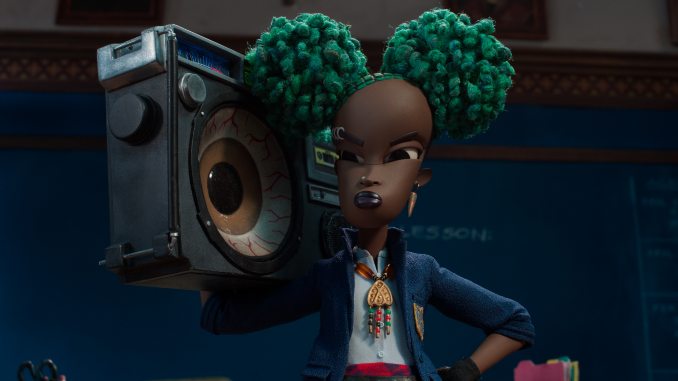
Henry Selick Brings Plenty of Ideas to Wendell & Wild, His Fun, Sad, Gorgeous Return to Animation
Early on, Wendell & Wild feels like it might not be for kids so much as inebriated adults. Over the course of its runtime, that is revealed to be a reductive appraisal—it’s a spooky coming-of-age comedy made of sad and dramatic moments which demonstrate the importance of community resistance to corporate control of the government. The plot has enough going on that it could have been a TV series or a two-parter, but for whatever its flaws or limitations, it flows coherently for 106 minutes to a satisfactory conclusion. All the while, it’s a marvel of artistry and artisanship, with a soundtrack full of Black-fronted rock bands to boot.
Kat (Lyric Ross), a young green-haired Black girl, loses her parents—pillars of their community—in a car accident and is roughed up over the years by the juvenile justice system as the film visually summarizes through shadow-puppet illustrations of memories. It’s a nice added layer, artistically and didactically. A grant-funded reintegration program brings Kat back to her now largely-deserted hometown, Rust Bank, and its eponymous private Catholic school. There, Kat discovers her supernatural connection to the underworld through Wendell (Keegan-Michael Key) and Wild (Jordan Peele). In addition to these literal demons she’s saddled with, Kat grapples with Rust Bank’s recent history: The school’s financial trouble, Rust Bank’s mismanagement and subjugation at the hands of Klax Korp, and the community’s resistance. Wendell & Wild could get weighed down by these heavy themes, but its combination of satire and silliness keeps it light on its feet.
Representation might be conceptually overrated, but it’s nowhere more necessary than in children’s media. Similarly, ”message” movies or socially conscious themes within films get a bad rap when panderingly attached to weak art or, conversely, as an afterthought. However, with intention, they can come about naturally when real-world destructive social-material forces are woven into the plot. That’s been done effectively, including in children’s animation, for a long time. Wendell & Wild doesn’t belabor any of its many points—that corporations have too much control over peoples’ lives, that mass incarceration is destructive, that inpiduals’ gender identities should be respected—it just communicates them clearly and moves forward.
It is a general net good that an animated film aimed at teens and tweens can clearly discuss issues like mass incarceration and the school-to-prison pipeline. It is of benefit that we have art aimed at minors with a flawed protagonist, who grows but doesn’t have all her edges sanded off. But that wouldn’t matter if the movie wasn’t good. Because the performances—from Ving Rhames, Angela Bassett and James Hong to Tamara Smart, Ramona Young, Sam Zelaya and everyone in between—are earnest and clever, because Key and Peele always have chemistry, because director Henry Selick and his co-writer Peele were able to effectively adapt the unpublished novel Selick co-wrote with Clay McLeod Chapman, it’s well worth watching.
What’s most charming is the craft, the painstaking creation of the models and backdrops (some of which are shown to the audience in making-of clips that run alongside the end credits). First you notice the way slushy ice-water in a pothole is modeled with gel… or do you first notice the contrast of vibrant colors with ominous darkness? Perhaps, instead, the use of multiple animation styles and physical textures to make the world seem more-than-real? It’s eye-catching, and if you’re worried the appeal is all in nostalgia, you’ll be glad to be reminded of why this art style captivated you in the first place. It isn’t about callbacks, but about commitment to craft; taking steps forward in the design and use of tools to move the medium forward—all bolstered by a soundtrack that effortlessly blends from background to diegesis.
As you may have guessed, Wendell & Wild’s biggest flaws are in how much it tries to cram in, though it’s paced well enough for the ending to come without it feeling cramped. Of course, this means they can’t develop an especially sophisticated thesis about any of the topics, but a beneficial consequence is that the movie doesn’t become lecturing. Related to the abundance of ideas going on are abrupt fade-in and fade-out transitions later in the film, which may be related to Selick’s creative choice to “[bring] back the original charm of stop motion animation, so that it wasn’t slick and perfect all the time.” But this alleged “imperfection” doesn’t feel amateurish or crass; perhaps there’s a nobility to imperfection, to everything seeming like it was made painstakingly, not so smoothly successful as to be without character or texture. It’s like how rear-projection or puppets can feel more real than CGI—we can imagine what it feels like to touch the components, and therefore imagine what it’s like to exist in that world.
Wendell & Wild reminded me of Beetlejuice and Nightmare Before Christmas, but it isn’t cribbing from what has come before. It’s building on it. Coming nearly 30 years after Selick’s first collaboration with Tim Burton, it can hardly be said to have the same members in the target audience, even if it aims for the same demographic. That he’s only made three intervening films—personal favorite James and the Giant Peach, the panned-and-forgotten Monkeybone and the widely lauded Coraline—is a deep shame, blamable in part on a lost decade of collaboration with Disney and Pixar. Regardless, kids and parents everywhere are lucky to have Wendell & Wild. Selick hasn’t directed a lot of movies, but his films have a lasting impact, etching themselves in the memories of their audiences for decades.
Director: Henry Selick
Writer: Henry Selick, Jordan Peele
Starring: Jordan Peele, Keegan-Michael Key, Angela Bassett, Lyric Ross, Ving Rhames
Release Date: October 28, 2022 (Netflix)
Kevin Fox, Jr. is a freelance writer with an MA in history, who loves videogames, film, TV, and sports, and dreams of liberation. He can be found on Twitter @kevinfoxjr.










































![iFi's GO Bar Kensei Dongle DAC Supports K2HD Technology With Some Samurai Swagger [Updated] iFi's GO Bar Kensei Dongle DAC Supports K2HD Technology With Some Samurai Swagger [Updated]](https://i0.wp.com/cdn.ecoustics.com/db0/wblob/17BA35E873D594/33FF/45A11/QTXOLJR4xDKSNMMk2WlTgjaIlvSgcYpeU1xJzUwIoYs/ifi-go-bar-kensei.jpg?w=768&ssl=1)
































